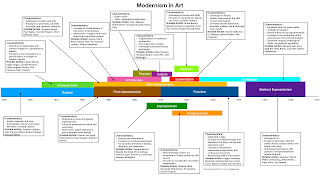Modernism, according to tate.org.uk, "refers to a global movement in society and culture that from the early decades of the twentieth century sought a new alignment with the experience and values of modern industrial life. Building on late nineteenth century precedents, artists around the world used new imagery, materials and techniques to create artworks that they felt better reflected the realities and hopes of modern societies." A second source (the collector.com) is in agreement with this definition except that (i) they limit it to the western world and (ii) they see it as a complete break with everything that went before (rather than a "build").
Many different styles are encompassed by the term modernism but they all are bound by a set of underlying principles (Tate):
- A rejection of history and conservative values
- Innovation and experimentation with form with a tendency to abstraction
- An emphasis on materials, techniques, and processes.
A graphical representation of the various art movements encompassed in the term modernism is provided below.
Abstract Expressionism
In the early 1940s, the East Village became the stomping grounds for a number of artists who congregated there, sharing ideas in a manner akin to the Impressionists in Montmartre. These artists shared "an interest in using abstraction to convey strong emotional or expressive content" and a "characteristic messiness and extremely energetic application of paint." These artists eschewed narrative and symbolism in their work, exploring, instead, "the literal act of applying paint to the canvas."
The figure below presents a graphical overview of the key characteristics of the movement.
Phoebe Hoban, in her book Basquiat: A Quick Killing in Art, compared the Abstract Expressionism movement to the later -- but geographically co-located -- Neo-Expressionism movement
... while the first movement shifted the tectonic plates of the art world from Paris to New York and shaped Western culture for the second half of the twentieth century, the second movement was merely a trendy fashion statement, a bleep on the radar ... The Abstract Expressionists came together to promote a cause, while the East Village artists came together to promote themselves.
According to Phoebe, the Abstract Expressionists put themselves on the map with a show on Ninth Street in 1951. Sixty-one artists displayed 61 pieces of art, the first time that the general public had had an opportunity to see the full scope of the movement's coverage.
Action Painting
One of the Abstract Expressionist works that I find especially interesting is Franz Klines Untitled. In the figure above, which describes key influences for the Abstract Expressionists, I mentioned the role of chance in the contours of the final product. Other action painters like Willem de Kooning and Jackson Pollock were dyed-in-the-wool improvisationalists. Kline's approach, however, "was methodical and meticulously planned before execution. His paintings started as drawings, which he projected at a larger scale onto canvas."
 |
| Franz Kline Untitled, 1960 Oil on paper |
 |
| Hans Hoffman Composition #3, 1956 Oil on canvas |
 |
| Jean Miotte Untitled, 1958 Oil on canvas |
 |
| Willem de Kooning Woman II, 1961 Oil on paper mounted on canvas |
 |
| Helen Frankenthaler February's Turn, 1979 Acrylic on canvas |
 |
| Michael Goldberg The Keep, 1958 Oil on canvas |
 |
| Joan Mitchell Aire pour Marion (Space for Marion), 1975-76 Oil on canvas |
 |
| Mark Rothko Untitled, 1968 Oil on paper mounted on canvas |
 |
| Theodoros Stamos Sentinel, 1962-64 Oil on canvas |
Expressionism and Repetition
Wherein the artists in the prior section reveled in spontaneity, chance, and improvisation, the artists spotlighted in this section were focused on symmetry and bounding colors within geometric shapes. The work by Richard Anuszkiewicz has a somewhat hypnotic look to it, with the green distinctly separated from the red. On closer examination one can be sucked into the myriad, connector-like lines that constitute that outer red layer. A truly complex construct.
 |
| Josef Albers Study for Homage to the Square, 1964 Oil on blotting paper |
 |
| Richard Anuszkiewicz Temple to Royal Green, 1983 Acrylic on canvas |
 |
| Frank Stella New Caledonian Lorikeet, 1980 Mixed media on Tycore Board |
 |
| Kenneth Noland Summer's Gold, 1983 Acrylic on canvas |
©EverythingElse238






No comments:
Post a Comment